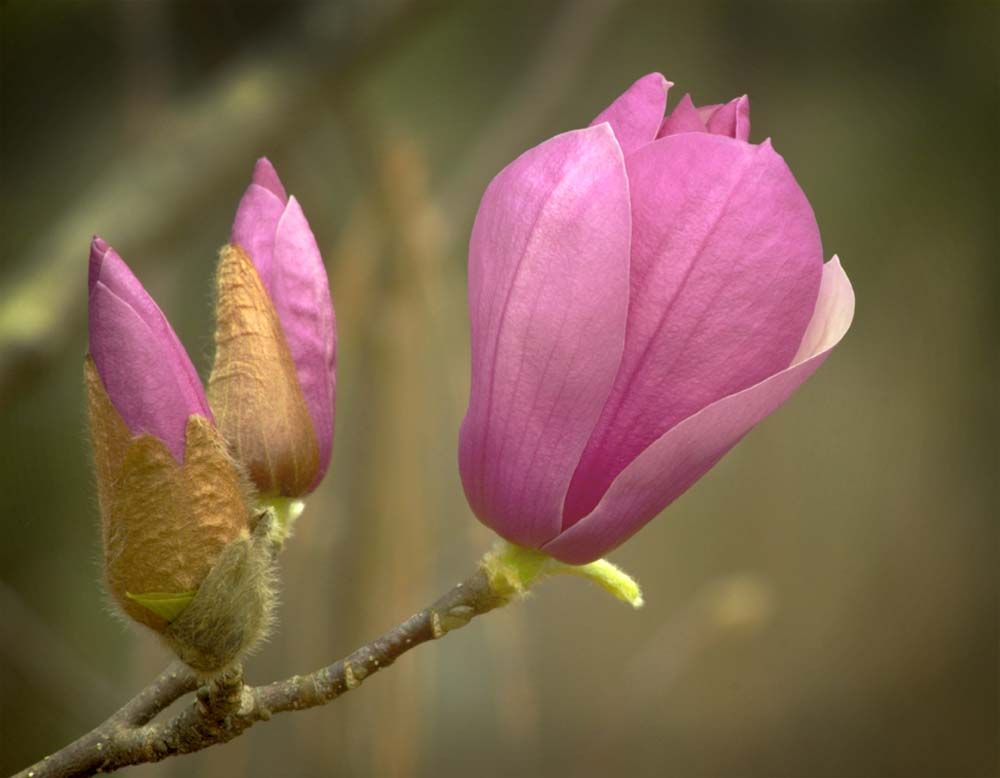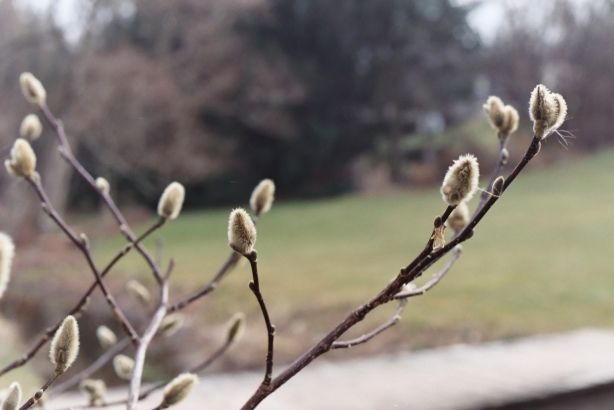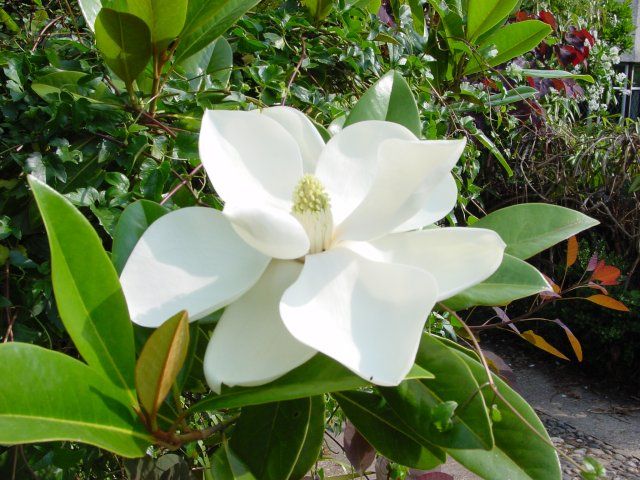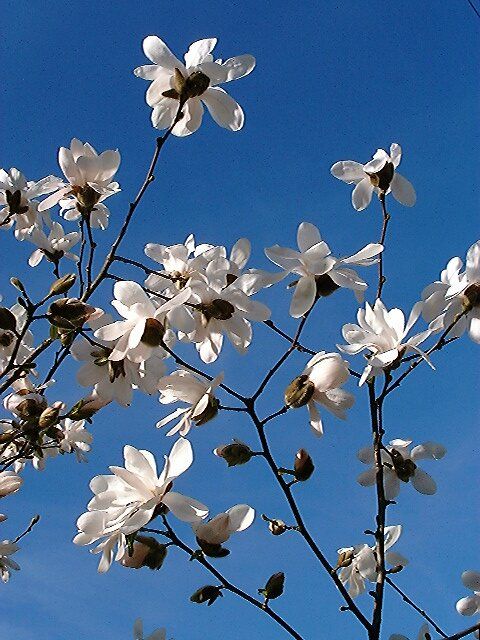Magnolia
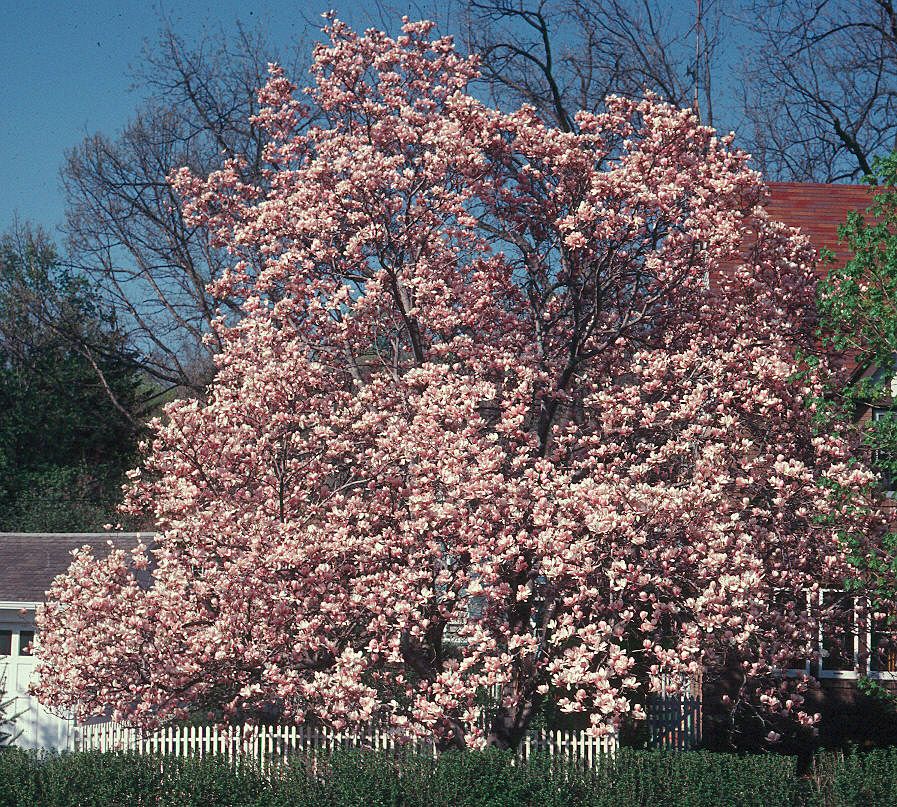
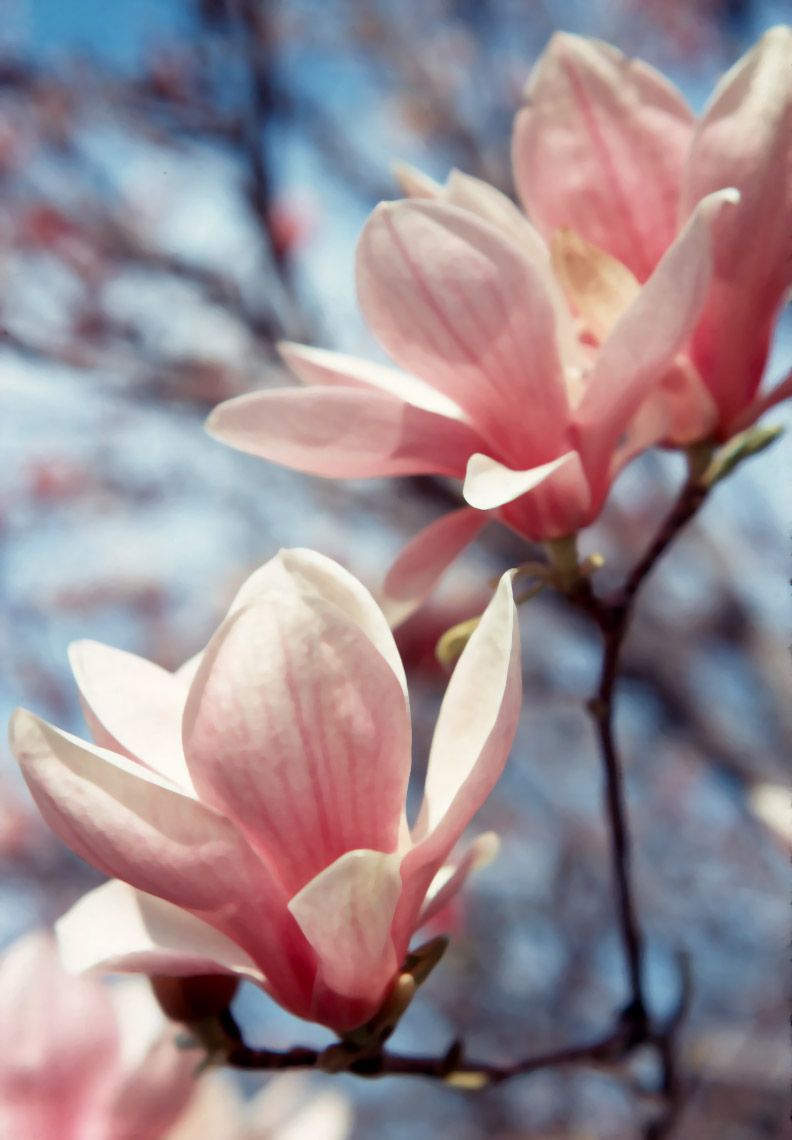
Family: Magnoliaceae
Form: Rounded, shrubby habit
Height: 12 to 15'
Width: 8 to 12'
Light: full sun, partial share
Soil: moist, well drained
Leaf: 4 to 8" alternate, simple dark green leaves; glabrous on underside
Flower/Fruit: 3 to 4" slightly fragrant deep red purple flowers; reddish purple stamens; opens flat; 1 to 2" cylindrical, deep purple to brown fruit in summer
Care and cultivation
Culture of magnolias is relatively simple. Once they are properly established, they require a minimum of care. One of the keys to success is to allow for the ultimate size of the magnolia, even if this means using temporary shrubs or plantings around it. Magnolias resent disturbance and do not transplant easily. Allow about 6.0m around the larger magnolias, less for narrower and smaller M. stellata.
|
|
|
Buying magnolias
You can buy two-year-old trees planted in containers or older trees that are balled and burlapped. If fat, woolly buds are visible on the older trees, you can expect a few blooms the year you plant. Magnolias that have a ball of soil around the roots do not dry out readily, and they are easily established. Do not buy bare-rooted magnolias.
Planting magnolias
The best time to plant magnolias is in early spring, before new leaves start to grow. The planting site should be about 12 feet on each side. Magnolias thrive in full sun, but they flower satisfactorily under the high shade of neighboring trees. Select a site protected from wind and offers either light shade or sun (magnolias in full shade can become scraggly and flower sparsely).
Magnolias prefer a well-drained, good garden loam that is rich in organic matter, compost or leafmould, much like their forest home. Plant when dormant to reduce the risk of the plant sulking!
After selecting a suitable location, dig a hole to set the tree. The hole should allow the root ball to sit on solid ground rather than loose soil. Do not 'bury' the plant but keep it at the same level as indicated by the soil mark on the main stem. Magnolias are surface feeders and planting too deeply will not make for a happy plant. Once the ball is set in the hole, the root flare on the trunk should be level with the existing soil.
|
|
|
After you plant the tree, cut any of the twine around the top of the root ball and fold back or cut off exposed parts of the burlap. Then refill the hole with peat moss, well-decayed manure, or leaf mulch. Press the soil mixture firmly around the root ball and scoop loose soil away from the top of root ball to form a basin for holding water. Stake new plants to help them to establish, removing the stake after one year. Water the plant thoroughly. A little 'NPK' fertiliser may provide a good start, but good irrigation for the first growing season is more important.
Avoid damaging the roots when working nearby, as this can easily set the magnolia back and can sometimes be fatal.
Mulching
After planting, cover the soil under the branches with a mulching material bark, wood chips or pine needles. Apply a layer about 3 inches deep. Add new mulching material periodically to maintain the mulch.
A mulch helps to keep the soil moist near the surface, where magnolia roots are most active. It also helps to prevent the growth of weeds. And as the mulching material decays, it releases nutrients for use by the magnolia tree.
Be careful if you use a hoe or other weeding tool around magnolias, you may harm the shallow roots.
|
|
|
Watering
Rainfall ordinarily provides enough moisture for mulched magnolias. They need about 1 inch of moisture every 14 days. In some areas, rainfall will provide sufficient moisture. In dryer areas, and during dry periods, soak the roots at weekly intervals. But be careful that you do not drown trees growing in poorly drained soil.
Fertilizing
If magnolias are planted in reasonably fertile soil that is well supplied with organic matter, they seldom need fertilizing. A soil test will indicate if fertilizer is necessary.
Pruning
Pruning is not necessary, although you can prune to reduce the size of your magnolia. Pruning removes flowering wood, reducing flowering the following season. The best time to prune magnolias is in late spring, after blooming, so that the pruning wounds will have time to heal during the growing season.
Propagation
Magnolias are usually propagated in two ways: sexually from seeds and asexually from vegetative tissue. Examples of asexual propagation are several - cuttings, grafting (chip-budding and side-grafting), layering and tissue culture.
Asexual propagation is used when it is desired to produce a new plant which is a genetic reproduction (clone) of a certain individual plant. In this case, the new plant carries forward the same name as the original plant from which the propagation material (scion) was obtained.
Sexual propagation creates seeds from cross-fertilization - the seed carries the genes of two parents. In the wild, this genetic diversity is important to the survival of the species.
In cultivation, fertilization can be used to create seedlings of species or to develop new hybrids - some of which may be an improvement over previous clones or at least have new, appealing characteristics.
In the reproduction of species, it is important to ensure that both parents are of the same species. Otherwise, the offspring will be hybrid and cannot carry the name of the parent plants. In any sexual reproduction it is necessary that the fertilization be performed in a controlled environment so that the cross-fertilization does not become contaminated by pollen from a third party. In hybridization, each offspring produced from seed is a unique plant and does not carry forward the name of either of its parents.
Hybridizers are always looking for new, improved clones. Some of these new clones, which have horticultural merit, are given cultivar names and introduced into the nursery trade via mass asexual propagation.
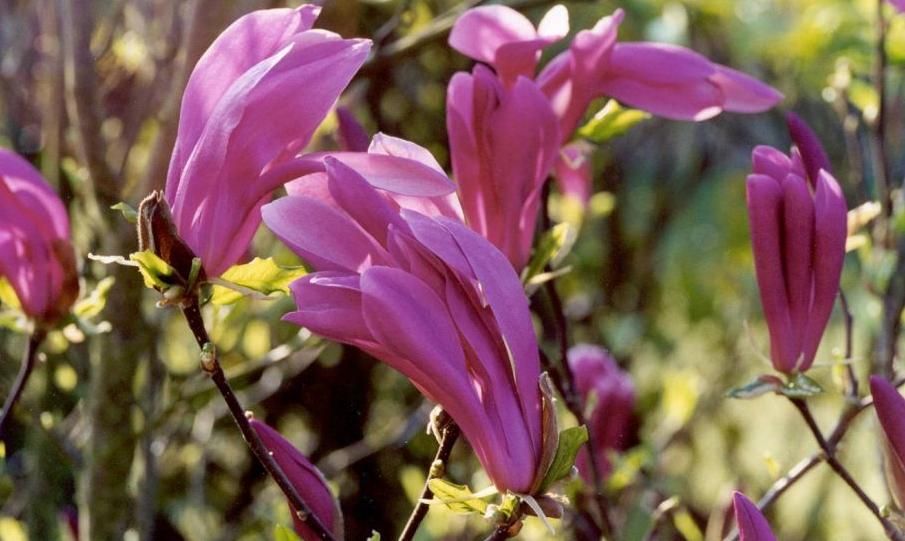
Pests and diseases
Magnolias seldom suffer serious damage from diseases and insects. A few diseases and insects affect magnolias, however. Inspect magnolias frequently for signs of diseases and insects described in this section.
Nectria Canker (European canker) - ordinarily does not kill magnolias, but it disfigures them. A few cankers on the branches do little harm. Cut out diseased bark and apply shellac to the wound.
Dieback - Freezing injury may cause dieback at the tops of magnolia trees. Late season growth is especially susceptible to dieback. Prune dead branches and twigs back to healthy wood.
Trunk Decay - Fungi that cause trunk decay can enter magnolia trees through wounds made by bumping the trunk with a lawn mower. If damaged trees have multiple stems, remove the damaged stems and then select young shoots to replace them. If you find decay in the trunk, cut out the diseased wood. Slope the bottom of the cut downward so water can drain away, and apply shellac to the wound.
Powdery Mildew - Powdery mildew sometimes develops on magnolia leaves of some varieties. Infected leaves are covered with a thin, cottony growth and may appear to have been powdered.
Tulip Tree Scale - Adult tulip tree scales are oval, dark-brown insects about 1/3 inch across the back. They usually crowd together on young stems, often near the ground. Their eggs hatch in August or September. Young scales are dull brown; they overwinter on the bark of magnolia trees. Scales suck the sap from the trees and thus cause branches to die and sometimes kill trees. The insects often coat the leaves with a clear syrupy liquid called honeydew. A black sooty mold then grows on the coating and the leaves thus are unsightly. Black sooty mold forms on the leaves.
Japanese Beetles - Magnolia grandiflora and other summer-flowering species may attract Japanese beetles. Adult beetles have shiny, metallic-green bodies and coppery-brown wings. They are about 1/2 inch long. Japanese beetles attack magnolia flowers in June and July. They feed on the petals and stamens. The edges of the petals first become ragged, then the flowers turn brown and curl.
Source:
www.magnoliasociety.org
Articole asemănătoare
-
Magnoliile Rosea
Varietate de magnolie cu flori mari, de un roz deschis, elegant, cu aspect decorativ deosebit, Rosea devine la maturitate un arbore cu o inaltime de pana la trei metri, ce poate fi plantat si intr-un spatiu mai mic.
-
Magnolia Heaven Scent, o alegere inspirata pentru orice gradina
Cu florile sale mari, numeroase, de un roz pur spre violet deschis, palid, cu tuse albe, aceasta varietate de magnolie este potrivita pentru orice gradina sau spatiu verde, dar devine centrul de atractie si interes mai ales intr-un spatiu relativ restrans.
-
Magnoliile Honey Tulip
Soi mai rar intalnit de magnolie originar din Noua Zeelanda, cu flori mari in forma de cupa si un colorit interesant, un alb crem spre galben palid, Honey Tulip poate fi acel arbust ornamental ce devine repede piesa de rezistenta a gradinii sau o necesara completare pentru un spatiu verde unde se simte nevoia unui plus de eleganta si cromatica.
-
Magnoliile Betty
Un soi hibrid ce poate ajunge la dimensiuni apreciabile odata ce a atins maturitatea, aceasta varietate de magnolie este un superb arbust care va creste pentru a forma cu ramurile sale o coroana ampla, deasa, plina in perioada de inflorire cu inflorescente in forma de cuba de un roz-violaceu intens, parfumate, cu textura delicata.
-
Magnolie Leonard Messel
Unul dintre cele mai populare si mai indragite soiuri de magnolie, Leonard Messel este o varietate de talie medie (la maturitate are in jur de patru metri inaltime) cu flori in forma de stea, de o nuanta roz cu tenta visinie si alb in interiorul celor 12 petale.
